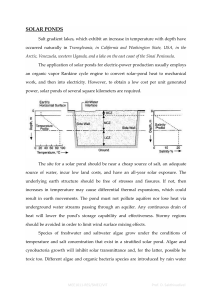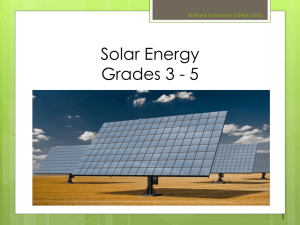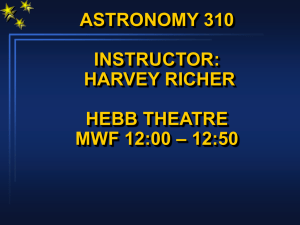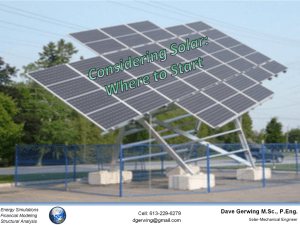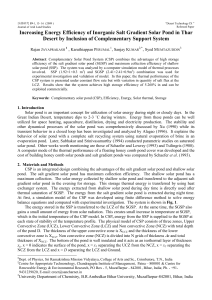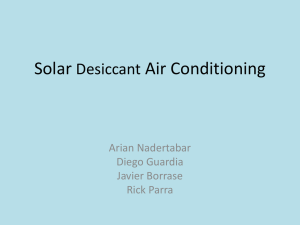Salt Gradient Solar Pond
advertisement
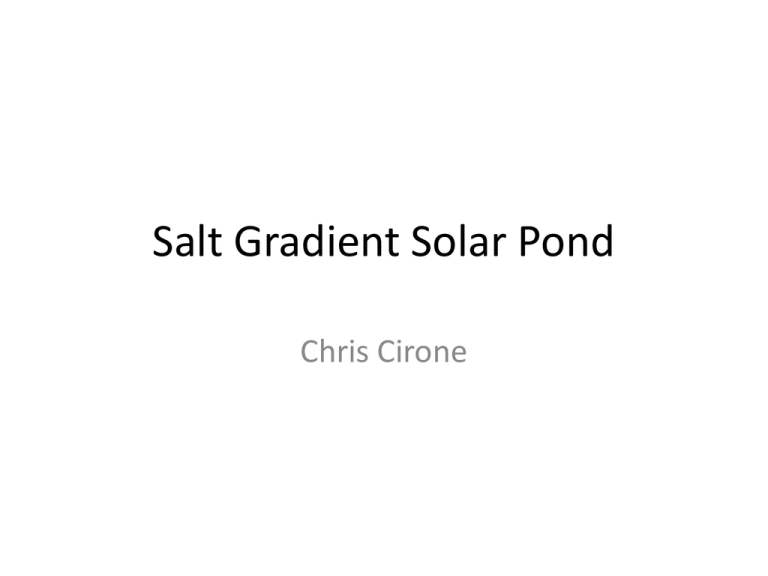
Salt Gradient Solar Pond Chris Cirone Solar Energy Collection and Storage • Uses radiation from sun to heat water • Stores sensible heat in dense saline water • Utilizes density gradient to prevent convective heat flow and therefore store thermal energy. • 3 Main layers in salt gradient solar pond – UCZ: upper convective zone – NCZ: non-convective zone – LCZ: lower convective zone Solar Pond Diagram 20-30% salt conc. 70-90 C (Newell and Boehm, 1982) Brief History • Phenomena first discovered in early 1900’s in Transylvania where with natural occurrence. • Significant research effort and publications began in 1960’s mostly in Israel. • Interest subsided until the energy crisis of the 70’s during which the research effort expanded globally. • Solar pond research comes to UIUC in 1980’s. University of Illinois Solar Pond http://www.newellinstruments.com/equinoxblog/122309.html University of Illinois Solar Pond • • • • • • Research lead by Ty Newell from Mechanical Engineering Constructed in 1986-87 2000 m2 salt gradient thermal energy storage solar pond Adjacent to hog research facilities which were partially heated by the pond during its active research phase. Cost: 35 – 50 $/m2 or 140,000-200,000 $/acre Expected payback: 7-11 years Cost per Sq. Meter $5 Excavation Lining Material $15 $9 $3 $3 (Newell et al, 1990) Labor Fence Salt Typical Construction • • • • Size can range from hundreds up to thousands of square meters in surface area. Range from approximately 1-5 meters deep. Typically lined with a layer of sand for insulation and then a dark plastic or rubber impermeable liner material. Typical salt used is sodium chloride. Magnesium chloride, sodium nitrate, sodium carbonate, sodium sulfate also reported to be used. El Paso Solar Pond Forming the Salt Gradient • High concentration brine solution mixed in bottom to form the storage layer. • Layers of decreasing salinity “stacked” on top of the storage layer using a horizontal diffuser. • Fresh water is the final layer pumped on the surface. Zangrando (1980) Maintaining the Gradient • Salt diffuses to surface trying to homogenize the solution- artificial maintenance required • Temperature distribution has destabilizing influence on pond Brine Re-concentration System – Charging pond destabilizes – Energy extraction stabilizes • Stability of gradient layer is dynamic • Other destabilizing factors: surface wind, gradient maintenance flows, convection in storage layer (Newell et al, 1990) Applications • • • • • Greenhouse heating Process heat in dairy plants Desalination Power generation Agricultural applications – Drying crops – Heating livestock buildings • Building space heating and absorption cooling Organic Rankine Cycle Rankine cycle that uses an organic, high molecular mass working fluid with boiling point lower than water. www.powerfromthesun.net/Chapter6/Chapter6.htm Pilot Plant in Israel (1980’s) http://www.motherearthnews.com/Modern-Homesteading/1980-05-01/Israels-150-KW-Solar-Pond.aspx “Zero Discharge” Water Desalination RO: Reverse Osmosis ED: Electrodialysis MSF: Multi-stage Flash MEMS: Multi-effect multi-stage BCRS: Brine Concentrator and Recovery System Process Heat for Milk Pasteurization in India • http://www.youtube.com/watch?v=KHCheEgh ok0 Design Improvements • • • • Reduce wall shading Increase ground insulation Uses mirrors to increase insolation Honeycomb insulation on surface – Prevent convection heat loss and wind disturbances References F. Zangrando, A simple method to establish salt gradient solar ponds, Solar Energy, Volume 25, Issue 5, 1980, Pages 467-470, ISSN 0038-092X, DOI: 10.1016/0038-092X(80)90456-9. Zangrando, F. On the hydrodynamics of salt-gradient solar ponds (1991) Solar Energy, 46 (6), pp. 323-341. Velmurugan, V., Srithar, K. Prospects and scopes of solar pond: A detailed review (2008) Renewable and Sustainable Energy Reviews, 12 (8), pp. 2253-2263. Newell, T.A., Cowie, R.G., Upper, J.M., Smith, M.K., Cler, G.L. Construction and operation activities at the University of Illinois Salt Gradient Solar Pond (1990) Solar Energy, 45 (4), pp. 231-239. NEWELL, T.A., BOEHM, R.F. GRADIENT ZONE CONSTRAINTS IN A SALT-STRATIFIED SOLAR POND. (1982) J SOL ENERGY ENG TRANS ASME, V 104 (N 4), pp. 280-285.
